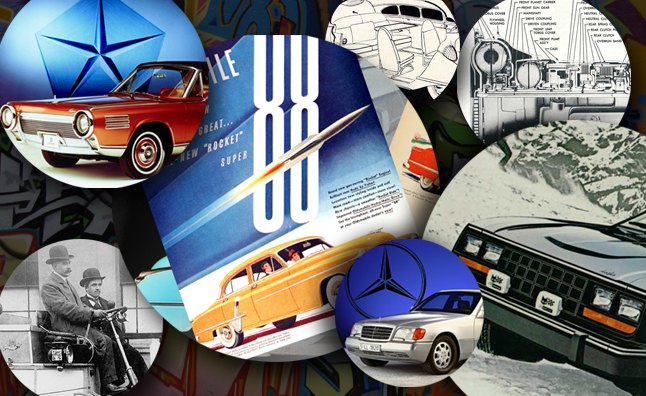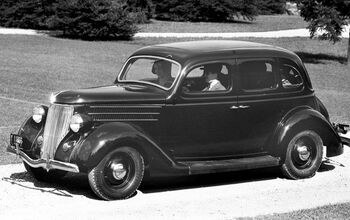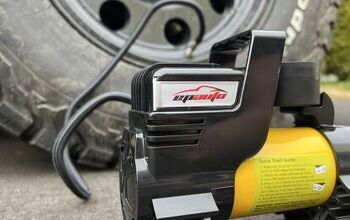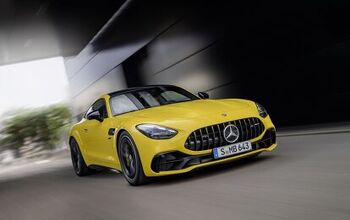Top 10 Most Important Cars You've Never Heard Of

Everyone’s heard of the Ford Model T and Toyota Prius. They’re two of the most significant – and best-known – vehicles produced by the automotive industry. Introduced at opposite ends of the last century they were each revolutionary in their own way, bringing about important changes that shaped the car business for years to come. But if you believe that’s the limit of automotive innovation think again.
There are literally dozens of other pioneering products that have changed the landscape of the car business – at least 10 of them in fact – some of which you’ve probably never even heard of. Take flight like an eagle and allow your friends at AutoGuide to introduce you to a goddess, and so much more.
American Motors was the result of a merger between two struggling car companies, Nash and Hudson. Usually two wrongs don’t make a right, but apparently two desperate automakers can build some pretty innovative vehicles. Case in point: the AMC Eagle.
This boxy ambassador of 1980s design is far more than just a high-riding passenger vehicle; it was America’s first car with four-wheel drive. The screaming Eagle kicked off the SUV fad that was soon to sweep America. Others would expand the segment – trucklettes like the rough-and-ready Jeep Cherokee and the immensely popular Ford Explorer, but the Eagle is largely credited with starting it all.
It swooped into the market as 1980 model and was offered in a number of different body styles including a two-door sedan and a station wagon. Regrettably though, the innovative Eagle would fall victim to another merger, Chrysler’s acquisition of AMC in 1987. The car was offered for one more year before going extinct.
What’s the opposite of success? Oh right, wretched humiliating failure, and that’s just what Cadillac had on its hands in the early 1980s courtesy of a brand-new fuel-saving technology.
If you haven’t guessed already, the next car on our list isn’t a car, but an engine. Called the V8-6-4 it was standard across the wreath-and-crest brand’s 1981 lineup with the exception of the Seville where it was optional. Here’s why it’s a part of this top 10.
In a bid to improve its Corporate Average Fuel Economy (CAFE), Cadillac developed a new powerplant. Internally it was referred to as the L62 and it featured a new-fangled technology called cylinder deactivation. Shutting down unnecessary cylinders when full power is not required is a terrific way to slash fuel consumption.
In theory the idea worked great, in practice it was something else entirely. Unsuspecting Cadillac owners of the time had to put up with severe drivability issues ranging from jerking and bucking to outright stalling.
What’s up with that? Well, it turns out the electronics of the era were simply not powerful enough to make everything work. Such was the state of computers during Ronald Reagan’s first term. Surprisingly though, the fundamentals of this engine were just fine and owners could simply disconnect the cylinder-deactivation system and run it as a V8.
Luckily for GM’s reputation and the buying public’s patience, the ill-fated L62 was phased out after only one year on the market.
The 1981 V8-6-4 may have been abjectly awful but it was tremendously pioneering. Cylinder deactivation would come into its own years later.
The efficiency-enhancing innovation was about a quarter-century ahead of its time. It took that long for the electronics-side of the technology equation to catch up.
A few years ago GM figured out how to make cylinder deactivation work and has been installing it on a number of its V8 engines. Chrysler also uses it on its famous Hemi. Other automakers have jumped on the bandwagon as well including Audi and Honda.
There was a lot going on in 1955. Europe was still being rebuilt from the ashes of World War II, which had gone out with a bang just one decade before. Eisenhower was in the White House, the Soviet Union was on the rise, and American exceptionalism and excess were out in force. It was in these uncertain times that one of history’s most significant cars launched.
The Citroën DS must have shocked the car-buying public like no vehicle had before and few have since. It featured more innovations than the German V2 rocket that rained down just a few years past, not the least of which was its striking design.
The car’s sleek, aerodynamic styling was unprecedented. At the time it must have looked like it descended straight from heaven, an appropriate metaphor since the name, DS, is a bit of a pun. “Déesse” in French actually means goddess.
And her headline feature was a hydropneumatic suspension system. This innovation gave the car a number of advantages over its competition. It delivered an incredibly smooth ride, and as a result the DS was often referred to as a “magic carpet.” Drivers could also adjust the ride height, perfect for traversing rough terrain. Additionally, the suspension was load-leveling and would automatically keep things on an even keel, perfect if there was heavy cargo in the trunk.
Amazingly, the suspension had one other trick up its sleeve. Wheels and tires could be changed without a jack. It could adjust accordingly to keep the car supported on just three wheels!
Other innovations included inboard-mounted disk brakes, a feature that reduced unsprung mass greatly benefitting the ride and handling. Later models had swiveling headlamps that would turn with the steering wheel.
The innovative Citroën DS was introduced in 1955 and remained in production for 20 years.
Volvo is best known as a champion of safety, but the Swedish automaker is not the only company dedicated to protecting drivers and passengers. Mercedes-Benz has had more than its share of life-saving advances.
After seat belts, one of the most significant automotive safety technologies is electronic stability control. ESC builds on the benefits of other systems including anti-lock brakes and traction control. It’s particularly effective on top-heavy vehicles like trucks and SUVs. Over the years it has saved many lives and prevented countless crashes.
While the Mercedes-Benz S-Class is hardly an obscure vehicle it has been a pioneer in many areas. In fact, the W140 model of the mid 1990s was the world’s first car fitted with ESC.
The National Highway Traffic Safety Administration (NHTSA) mandated ESC on all new passenger vehicles sold after September 1, 2011, but most manufacturers beat that deadline by years.
As for the benefits of stability control, NHTSA estimates that if the nation’s entire vehicle fleet were equipped with the technology up to 8,200 lives could be spared every year. But given how many older cars are on the road the adoption rate will never hit 100 percent. Additionally, NHTSA figures that ESC alone saved more than 2,200 lives between 2008 and 2010.
“Step in my Rocket and don’t be late, baby we’re pullin’ out about half-past eight.”
A ground-breaking, toe-tappin’ tune (look it up, it’s great!), “Rocket 88” is likely the only song ever recorded about an Oldsmobile, but Jackie Brenston and His Delta Cats had a lot to sing about.
Widely considered the world’s first muscle car, the Olds Rocket was introduced in 1949. It offered drivers potent V8 power in a relatively small package, hence the reason it was both the subject and title of the world’s first rock-and-roll song.
The car’s engine was on the forefront of a trend that would soon sweep Detroit. Displacing about 304 cubic inches it featured a large bore, small stroke and most importantly, overhead valves. Flathead engine technology was on the way out by the middle of the last century and Oldsmobile was part of the reason. Moving the valves out of the block and putting them above the pistons allowed for much greater airflow and more power.
Henry Ford had popularized the V8 engine layout. In 1932 he was the first to deliver an affordable car with a two-by-four under the hood. But Ford’s depression-era performance advantage was rapidly fading in the years following the Second World War. The flathead may have brought power to the people and spawned the hot-rod revolution, but it was completely outgunned by larger, more efficient powerplants in cars like the sprightly Oldsmobile Rocket 88.
There is a wide variety of alternative powertrains on the market today. Aside from traditional internal combustion, drivers can choose from plug-in electrics, diesels, natural gas-powered vehicles and more. Really, there’s never been more on the automotive menu that what’s offered today.
In the 1960s carmakers were eager to incorporate aircraft-inspired features in their designs. Things like tailfins, winged hood ornaments and cockpit-styled interiors were all in vogue. Not surprisingly, those jet-age aspirations found their way under the hood as well.
In 1963 Chrysler introduced a revolutionary new car that was powered by a turbine, the same kind of engine hanging under the wings of a Boeing 707. Designed by Elwood Engel and assembled by Ghia in Italy, 50 test cars were built for limited consumer evaluation.
The idea was revolutionary, no pun intended. Turbines could run on just about any flammable liquid from jet fuel to diesel to gasoline and even Scotch whiskey. Ultimately there were drawbacks to the design and Chrysler pulled the plug, destroying nearly all of the test cars in the process. A few made it to museums and private collections.
While turbine engines may have been less than perfect as an automotive powerplant they do hold promise for the future. As automakers switch to hybrid drivetrains turbines could be great as an electrical generator, serving as a “range extender” in cars like the Chevy Volt.
Chrysler invented the modern minivan when it introduced the Dodge Caravan and Plymouth Voyager in 1984. They delivered car-like driving dynamics in a spacious, functional package, and they moved like beer nuts during happy hour. Surprisingly though, these family icons were not the first of their breed.
Arguably the earliest minivan was introduced in 1936. Frankie D. was president, the Great Depression was in full force and when it came to cars, William Bushnell Stout thought Americans deserved a “new deal.”
With its bulbous bodywork the aptly named Scarab offered drivers unheard of utility and passenger room in a streamlined, bullet-shaped vehicle. Overall it looked a lot like the abortive Chrysler Airflow that was in its second-to-last year on the market.
The car took advantage of weight-saving aircraft-style construction techniques. This automotive innovation was no surprise given Stout’s history building planes.
Today’s minivans share much of the Scarab’s DNA. They feature voluminous interiors, independent suspension, unibody construction and short front ends.
The reason the Scarab was so exceptionally pug-nosed was that the engine, a Ford flathead V8, was mounted in the rear. This puts the heaviest part of the vehicle right on top of the drive wheels for maximum traction.
Today, the Stout Scarab is largely forgotten because so few were built. Given the sticker price it’s not hard to understand why. They reportedly cost $5,000 when new, an astronomical figure in 1936.
The 1948 Tucker was an enormously promising and prescient automobile, but the company building it failed in spectacular fashion, possibly stalling automotive innovation for decades.
World War II put the brakes on all carmakers in the United States. They were deputized to manufacture weapons ranging from guns and bombs to tanks and aircraft. You name it, and it poured forth from Detroit’s factories and other plants around the United States like a tsunami of destruction. The “Arsenal of Democracy” was running full bore and nothing could stop it, not even the Nazis.
Naturally, automakers couldn’t develop new products during the war so when the conflict ended they were forced to sell warmed-over 1942 models. Not that it mattered; the cash-flush, car-starved public bought up anything they had to sell.
It was in this frenzied market Preston Tucker tried to introduce a revolutionary new car and beat Detroit at its own game.
His innovative sedan, nicknamed the “Torpedo,” had fully independent suspension, a padded dashboard with recessed knobs for safety, a pop-out windshield as well as a steerable “Cyclops” center headlamp. It was powered by rear-mounted flat-six derived from an aircraft engine.
But all the innovation in the world couldn’t protect the newborn company from scandal. Under suspicious circumstances Tucker, founder of the organization, became a target of the U.S. Securities and Exchange Commission. A couple years later he was exonerated but the damage had been done.
The negative publicity swirling around the investigation destroyed his firm. Only about 50 Tuckers were built, a sad end to a truly innovative vehicle.
Believe it or not, GM’s extinct Oldsmobile division used to have a reputation for technological innovation. As shown, the brand was one of the first on the market with a powerful, overhead valve V8 engine as seen in the Rocket 88. It was also the first to deliver a commercially viable automatic transmission.
Automotive enthusiasts may loathe so-called “slushboxes,” which have basically taken over the market in North America, but everyday drivers have completely embraced them. More than 90 percent of new vehicles sold in the U.S. are equipped with automatic transmissions.
Oldsmobile sought to make driving easier 70 years ago when it introduced its Hydra-Matic gearbox. The clutchless, self-shifting transmission was a $57 option on any of its 1940 models. It featured a fluid-filled torque converter and four forward speeds, a mid-century technological tour de force.
Interestingly, Hydra-Matic is a name GM still uses today.
Think Toyota’s Prius was the first gasoline-electric hybrid? Think again. That distinction goes to a vehicle produced more than a century ago. See, they really did think of everything back then!
Called the Lohner-Porsche, it was the world’s first series hybrid. As its name suggests, the vehicle was the result of a partnership between Ferdinand Porsche and an Austrian carriage-maker, the “Lohner” half of things.
As for the vehicle, it featured four electric hub motors, one mounted in each wheel. It was hauled around by an array of onboard batteries that were juiced by a small generator. In concept it’s identical to modern hybrid vehicles. However, in practice it was quite different.
The open-air car was hugely expensive to manufacture and required literally tons of lead-acid batteries. Given the excessive weight it was extremely impractical. (Sounds like a familiar problem). The Lohner-Porsche was hampered by the battery technology of its era, as are today’s all-electric cars. Still, it was an idea that was nearly a century ahead of its time.

Born and raised in metro Detroit, Craig was steeped in mechanics from childhood. He feels as much at home with a wrench or welding gun in his hand as he does behind the wheel or in front of a camera. Putting his Bachelor's Degree in Journalism to good use, he's always pumping out videos, reviews, and features for AutoGuide.com. When the workday is over, he can be found out driving his fully restored 1936 Ford V8 sedan. Craig has covered the automotive industry full time for more than 10 years and is a member of the Automotive Press Association (APA) and Midwest Automotive Media Association (MAMA).
More by Craig Cole









































Comments
Join the conversation
I loved this. It was really interesting and informative. Thanks
Don't know if you knew this Craig, but the Eagles and Cherokees were sold side by side for a short period of time since AMC owned Jeep for the last 20 years before being bought by Chrysler for the Jeep brand. IIRC, Chrysler's Turbine program was started shortly after WW2 and died right around the time they went bankrupt the first time. Even though the turbine engine has yet to make it into a regular production vehicle, Chrysler had some ownership in the manufacturer of the Abrams tanks and I've often wondered how much of their turbine tech went into the Abrams instead. BTW, the Turbine Cars weren't the only Mopars capable of burning whiskey........their 2.7l and Pentastar V-6's as well as the 4.7l V-8 are all built to be capable of burning corn whiskey. The Pentastar is quite fond of the stuff and my 4.0l I-6 Jeep don't seem to mind a couple gallons being splash blended every once in a while too :D